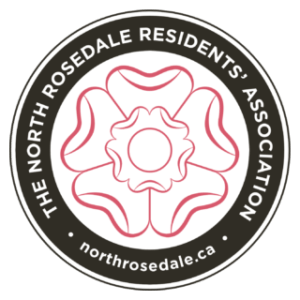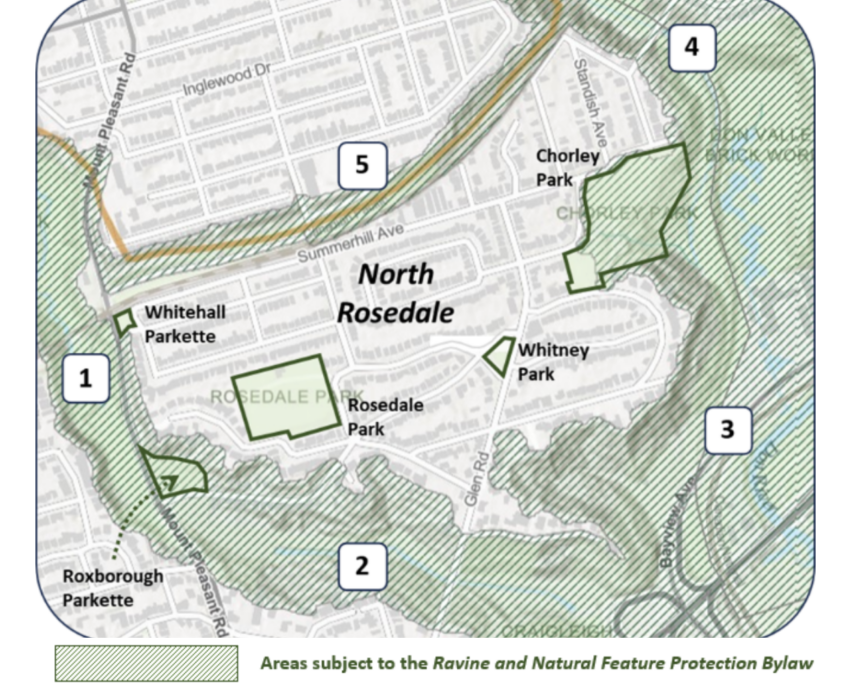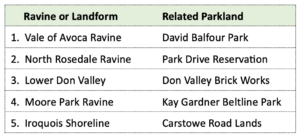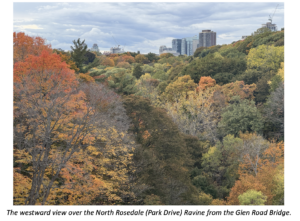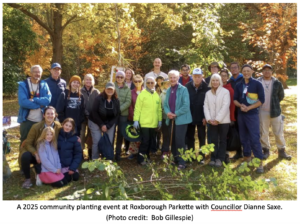Preserving and enhancing our parks, ravines and green spaces through neighbourhood stewardship and advocacy; promoting wellness and community through enjoyment of our parks.
Toronto calls itself a city within a park. A visit to North Rosedale demonstrates why this is such an appropriate motto. Ravine lands are the signature feature of Toronto’s green spaces, and our neighbourhood is bounded by ravines and related landforms in all directions (see map below). These include the Vale of Avoca, the Park Drive Lands, and the Moore Park Ravine which leads directly to the magnificent Lower Don Valley. The northern boundary of our neighbourhood is the Lake Iroquois Shoreline, an escarpment that formed the shore of a giant lake that existed briefly as the glaciers receded 13,000 years ago. These green spaces play a critical role in maintaining biodiversity and mitigating the impact of climate change, while providing recreational opportunities critical to the well-being of all of us.
North Rosedale Ravines and Parks
In addition to the natural parks represented by our local ravines, North Rosedale has traditional urban parks that are designed to support a range of uses and activities.
Chorley Park – the former grounds of the residence of Ontario’s Lieutenant Governor, this park of about five hectares includes maintained lawns, flower beds, and a variety of stately trees, and provides access through a switchback to the Beltline trail and the Don Valley Brick Works park.
Rosedale Park – this three hectare park is a hub of four-season recreational activity, and includes a playground, skating rink, playing field, and tennis and pickle-ball courts. It is also the venue for the Mayfair community fun fair, along with other seasonal community programs.
North Rosedale has three smaller parks (or parkettes) which generally are spaces for “passive recreation and retreat”, including Roxborough, Whitney, and Whitehall parkettes.
Enjoying our Parks
The NRRA actively promotes enjoyment of our local parks by residents and visitors alike. At Rosedale Park, many of our youngest residents enjoy a fantastic children’s playground. Its refurbishment in 2013 and 2014 was made possible by the vision and support of the NRRA and local residents.
For many years, the NRRA’s annual skating party in Rosedale Park represents a kick-off to the holiday season, as neighbours gather for skating, hot chocolate, and other holiday treats.
Each April, neighbours roll-up their sleeves and come out to our local park for our annual Clean-up Day, gathering any litter lying around, and getting the parks ready for the upcoming season.
Connectivity is a great feature of our ravine system. Heading into the ravines via the Chorley Park switchback leads not only to a range of activities at the Brickworks, but also to the Lower Don and 72-km City Loop multi-use trails. The Moore Park, Park Drive, and Avoca ravines are connected in a 7km local loop through Mount Pleasant Cemetery, while also joining the Beltline trail leading to the Yonge Street corridor and midtown connections to the west.
The connected ravines are enjoyed by dogwalkers and their dogs. The nearest off-leash dog parks can be found at the Brick Works and at Craigleigh Gardens, reached via Glen Road or through the ravines by Milkman’s Lane. Dogs should be kept on leashes in local parks and ravines.
A Tradition of Stewardship
The NRRA and the local community have a long tradition of advocacy and stewardship for our green spaces. The Association took an active role in efforts to protect the Park Drive lands in response to plans (cancelled in 1961) to use that ravine for a proposed Cross-town Expressway (to connect with the then-planned Spadina Expressway). More recently, the NRRA and other neighbourhood groups successfully opposed the installation of a commuter rail servicing facility in an environmentally significant location in the nearby Lower Don Valley.
The overdue restoration of the Vale of Avoca ravine is a current area of focus, with the NRRA collaborating with other local residents’ associations through the Midtown Ravines Group.
Working closely with Councillor Dianne Saxe, the group will contribute to a 2026 process for the development of a master plan that will aim to stabilize creek and ravine erosion, rebuild the Avoca trail system, and implement a longer term plan for the ravine’s ecological restoration.
The NRRA has been please to support local stewardship efforts, including continuing work in Roxborough Parkette by volunteers coordinated by Toronto Nature Stewards under an agreement with the City. In 2019, the NRRA coordinated community volunteers for tree and shrub planting in Chorley Park, in order to re-naturalize the trails connecting the park with the ravine system.
North Rosedale Trees
North Rosedale is blessed by an exceptional tree canopy. Populating our ravines and streets, trees are essential to the identity of our neighbourhood and its enduring beauty. Active protection of our endowment of street and parkland trees is a core value shared by our residents and the NRRA itself. As of 2025, according to official measures tracked by the City of Toronto, North Rosedale has the highest measure of tree canopy (66%) in the city except for High Park (source: City of Toronto Tree Webpage). The City’s has a 40% goal for overall tree canopy by 2050. The imperative for North Rosedale is responsible stewardship of our current endowment.
There are important bylaws that serve to protect trees in the City, on both private and public land. The Tree Bylaw (Municipal Code Chapter 813) sets out rules applicable in general to trees on private lands. This bylaw stipulates rules that homeowners must follow where the removal of a tree is under consideration, or if a project has potential to harm a tree. Proposed changes to this bylaw are anticipated in 2026, which are expected to strengthen tree protections in various way. The Ravine and Natural Feature Protection Bylaw (Ch. 658) imposes additional protections for trees in areas subject to that bylaw, including many ravine lots in North Rosedale.
The City has an ongoing challenge with the prevalence of invasive tree and shrub varieties among the tree canopy. Common invasive varieties include, for example, Norway maple, common buckthorn, certain honeysuckle varieties, and black locust. These varieties frequently outcompete native plants and trees, are not well integrated in local food chains, and can exacerbate ravine slope erosion. North Rosedale homeowners are encouraged to learn about invasive plants and trees and to develop plans that allow native plants and trees to flourish on their lots. There are many valuable sources of on-line information on invasive plants, including the Ontario Invasive Plant Council.
In 2025 the NRRA was pleased to sponsor a guided tree identification walk in Chorley Park, and a walking tour of invasive plants in the Vale of Avoca.
